6. If You Had Wings (1972 – 1989) // Buzz Lightyear’s Space Ranger Spin (1998 – Today)
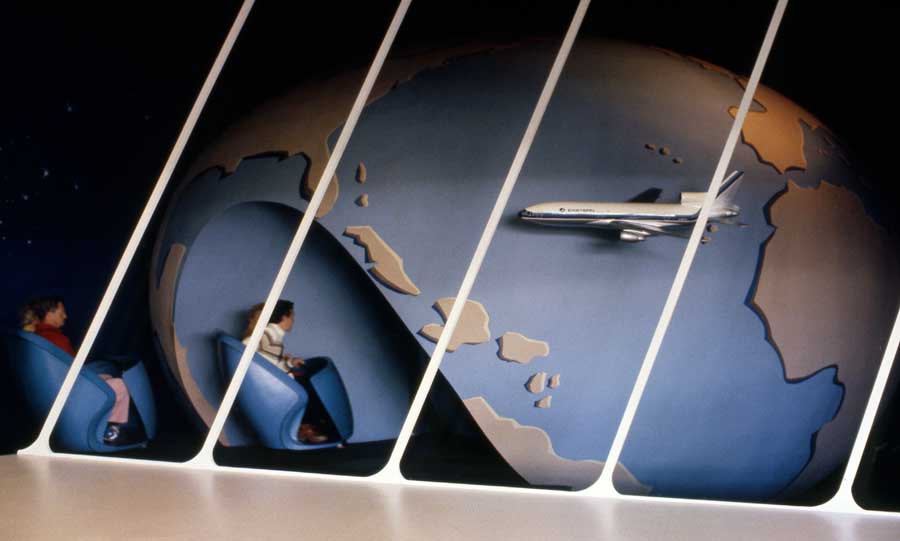
Another mid-century, Tomorrowland-set, early-Omnimover dark ride designed by Claude Coats, it’s no surprise that the Lost Legend: If You Had Wings is sometimes considered a “sister ride” to Adventure Thru Inner Space. Here gliding into a massive globe rather than a microscope, If You Had Wings used physical sets and integrated film projection to showcase destinations served by Disney’s official airline partner, Eastern Air Lines.
After Eastern Air Lines folded, If You Had Wings was “de-branded” as If You Could Fly, losing its iconic Buddy Baker song. Soon after, the ride was redesigned as Delta Dreamflight (likewise, later “de-branding” as just Dreamflight) until Tomorrowland’s run of aviation-themed dark rides came to an end thanks to the unexpected success of Toy Story.
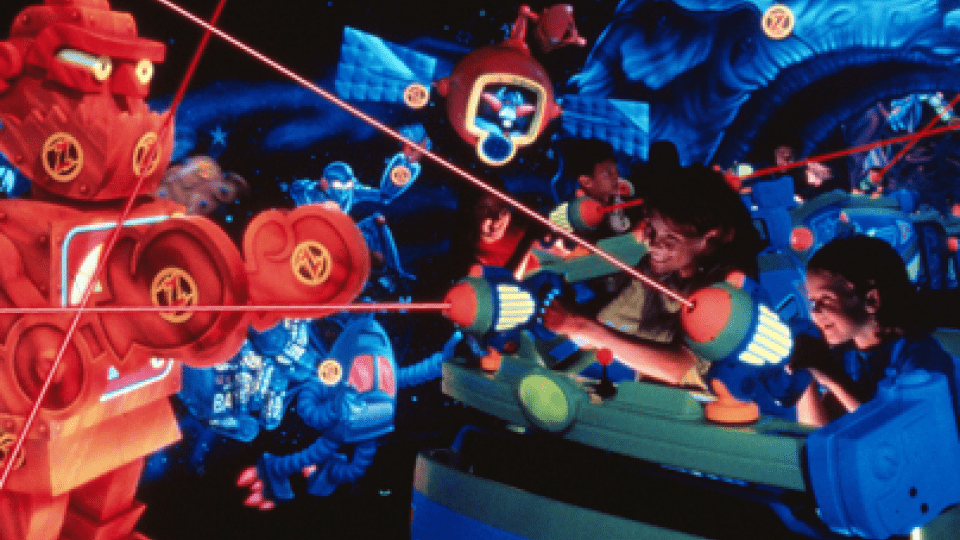
Buzz Lightyear’s Space Ranger Spin was an early step in the “Pixarification” of Disney Parks that we explored in our Member-exclusive Disney•Pixarland Special Feature. Today, of course, the saturated, cartoon colors and glossy, plastic sheen of Star Command are the de facto look of Tomorrowlands, which have largely become character catch-alls. In fact, a Buzz dark ride is one of just three attractions to have been found at every single “Castle Park” on Earth… though one of them has sent Buzz packing to infinity and beyond.
THEN & NOW: If You Had Wings and Buzz Lightyear’s Space Ranger Spin seemingly have few similarities aside from the unchanged track layout. But there’s one element that they share: the “Speed Room.” In 1972, the cutting-edge, ellipsoid-shaped chamber used 70mm projection to surround guests in the motion of airplane take-offs, speedboats, motorcycles, and more that – when combined with an ascending track and wind – created a surprisingly-convincing, disorienting illusion of speed.
Today, it serves as the final showdown with Emperor Zurg, making guests feel that they’re racing through the stars. So even though a Buzz Lightyear dark ride can be found at nearly every Disney Resort, only Magic Kingdom’s uses the inherited Speed Room for such an action-packed finale, making the original ride the most one-of-a-kind.
7. Jurassic Park: The Ride (1996 – 2018) // Jurassic World: The Ride (2019 – Today)
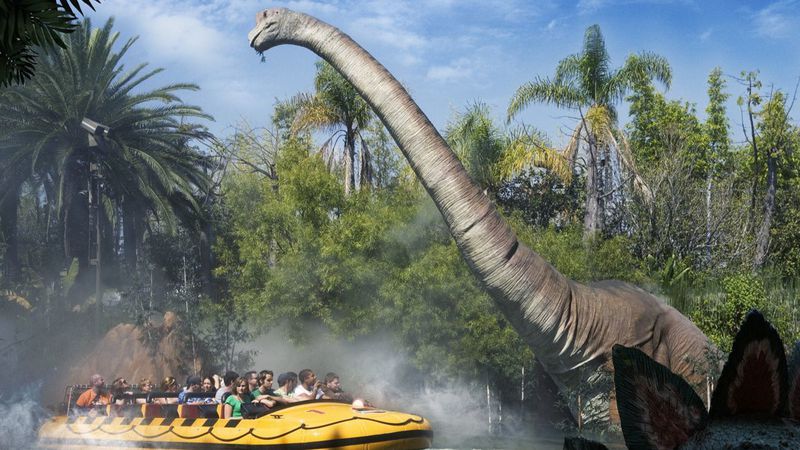
Steven Spielberg famously convinced Universal Studios executives to option Michael Crichton’s 1990 novel Jurassic Park before it was even published; then, Universal Studios Hollywood began construction on a ride adaptation of the film before the 1993 movie had even premiered. Both risks turned out to be very good decisions.
The Lost Legend: Jurassic Park – The Ride opened in 1996, continuing Universal’s tireless race to best even Disney’s E-Ticket standards in the ’90s “Ride the Movies” arms race. The boat-based attraction wasn’t actually seen in the film, but felt like just the kind of ride that might’ve existed just off camera, offering a rafting-style river tour of the park’s naturalistic herbivore environments.
Of course, something goes horribly wrong (doesn’t it always?) with a playful hadrosaur accidentally knocking guests’ boat off course and into the park’s industrial, backstage Environmental Systems Building, where escaped carnivores have taken up residence. The ride ends with the show-stopping entry of the T. rex herself in one of the best Audio-Animatronic moments in any theme park.
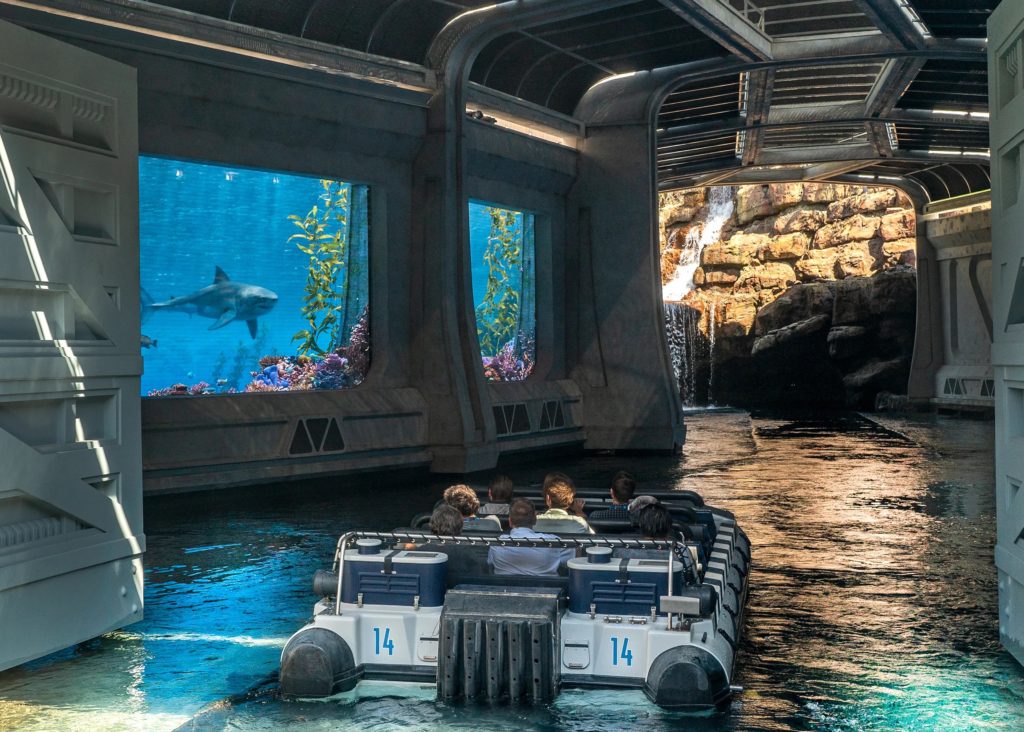
In 2015, the Jurassic franchise was reborn by way of a new trilogy – Jurassic World. Set in modern times, the sequel series explores a modern mutation of the park, now elevated from a bougie one-percenters boutique resort into a sprawling, Disney World-esque park of stadiums, thrill rides, and roller coasters. But Jurassic World’s biggest attraction is a cast of headlining dinosaurs designed by geneticists rather than nature, including the Indominus rex – a hyper-predator whose inevitable escape kicks the film into high gear. In 2018, Hollywood’s Jurassic Park: The Ride closed for a changeover…
THEN & NOW: Swapped from Jurassic Park’s yellow and red aesthetic to the sleek blue and steel of World, the two iterations of a Jurassic ride obviously share a layout, a general flow, and even some show scenes (like Stegosaur Springs). But around every corner, there are differences to be spotted from the obvious (a new and highly-effective Mosasaurus tank exhibit replacing the somewhat aged Ultrasaur Lagoon opening act) to the subtle (the showbuilding shifting from a backstage facility to a planned stop on the tour – the T. rex Kingdom – where the escaped Indominus is lurking).
Frankly, there are some moments of Jurassic World: The Ride that feel like slight downgrades compared to the ’90s classic. But there are far more that are smartly-staged upgrades, up to and including the iconic finale, now adding a breathtaking Audio-Animatronic Indominus rex and Blue, the Velociraptor to the pre-drop chaos.
8. Superstar Limo (2001 – 2002) // Monsters Inc. Mike & Sulley to the Rescue (2006 – Today)
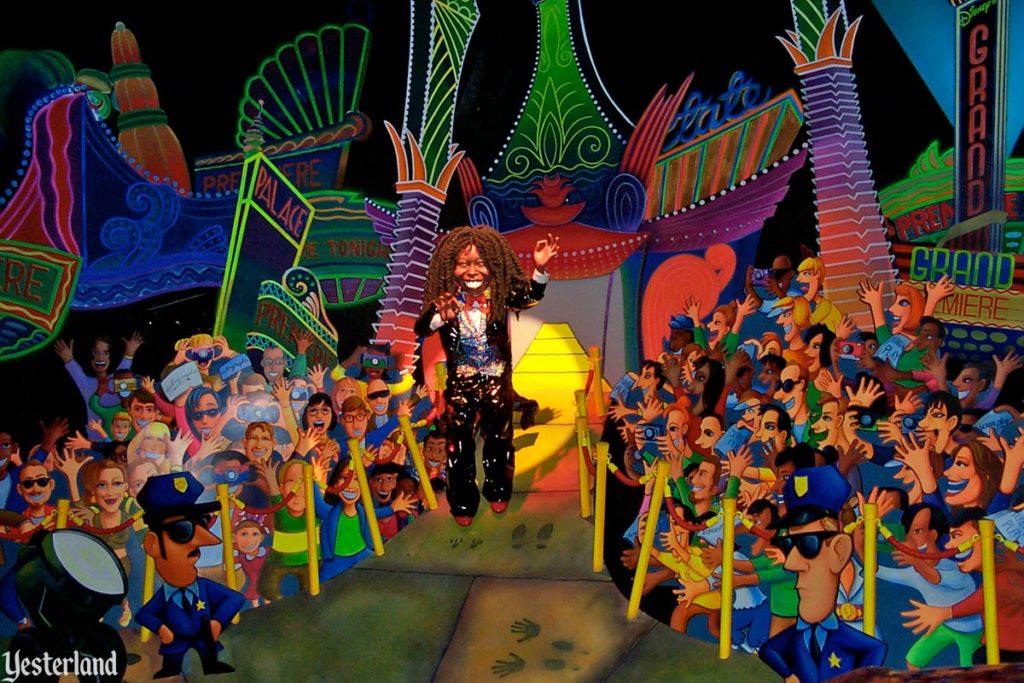
When Disney’s California Adventure opened in 2001, practically no one had anything good to say about the park. But one ride in particular was pretty unanimously recognized as the park’s biggest mistake. Leaning into the “brash,” “edgy,” “Californian attitude” and the “MTV” aesthetic designers hoped would be the park’s signature, the Declassified Disaster: Superstar Limo was an awkward, coarse, hyper-stylized dark ride through Los Angeles neighborhoods with comic book-like sets and caricatured figures of C-list celebrities.
Superstar Limo was so universally reviled that the ride closed before the park’s first birthday – even with nothing planned to replace it. Think about it: that means that executives and Imagineers agreed that California Adventure was stronger with no dark ride at all than with Superstar Limo. The soundstage housing the dark ride sat quietly in a dead-end corner of the park – locked away with lights off – for years.
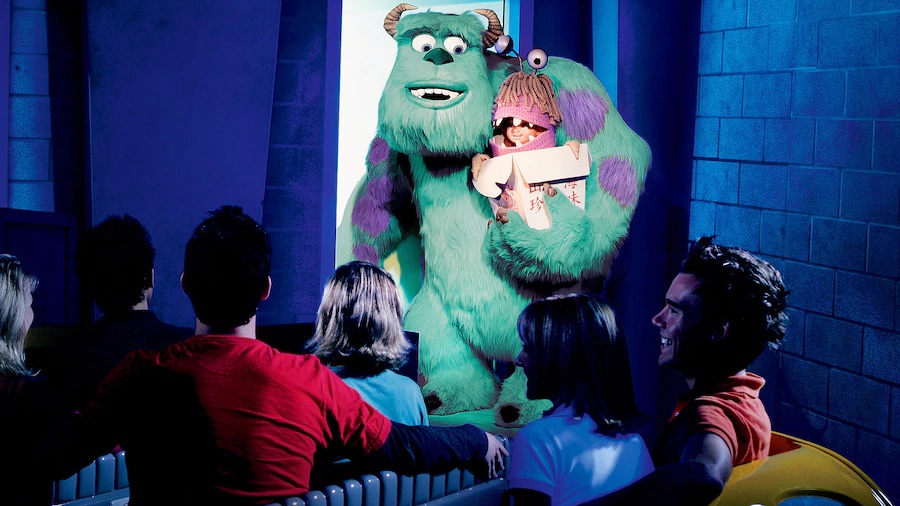
Then, in 2006 – as part of then-President Matt Ouimet’s push to right the wrongs of the preceding decade and return Disneyland to prominence during its 50th Anniversary celebration – Hollywood Pictures Backlot got a new dark ride. Well, not new new…
Monsters Inc. Mike & Sulley to the Rescue finally repurposed the bones of Superstar Limo, turning cartoonish Hollywood limousines into Monstropolis taxi cabs. Sure, it’s just a cute-if-simple “book report” dark ride with some smart staging and clever effects, but it was also a triple threat, giving the young California Adventure much needed family capacity, more Disney characters, and a solution to the Superstar Limo problem.
THEN & NOW: Thankfully, there’s practically no remnant of Superstar Limo to be found in Mike & Sulley to the Rescue aside from the dark ride’s entry “tunnel” wherein in-vehicle video becomes riders’ focus. Especially since Superstar Limo was so staggeringly short-lived, even those who experienced it twenty years ago probably couldn’t feel certain that the layout is unchanged…
Rather than any particular scene or maneuver, the most noteworthy reminder of the building’s former inhabitant is probably a hilarious and widely-known Easter egg: haz-mat suited CDA agents throughout the Monsters Inc. ride just so happen to have the same postures and poses as Superstar Limo’s C-List celebrity stars… Hmm… In any case, this is one “Then & Now” where seeing how Imagineers made use of what they were given actually makes us appreciate the result even more.
9. Merlinwood (1999 – 2008) // Hogsmeade (2010 – Today)
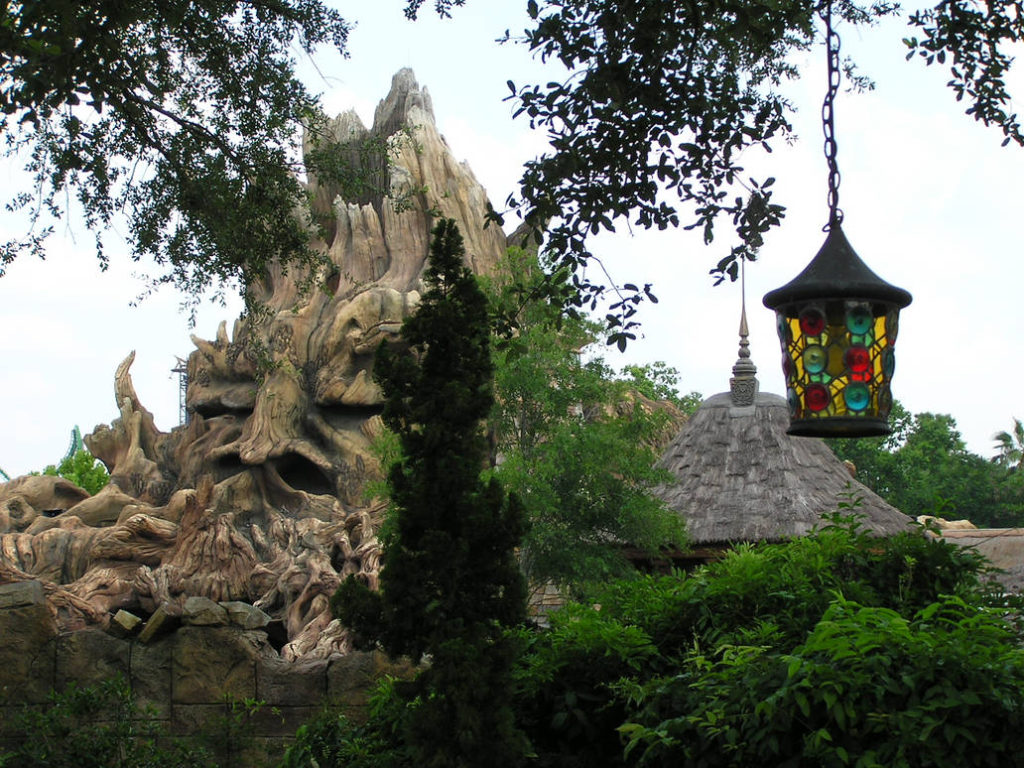
Today, it can be difficult to remember that there was a Universal Orlando before The Wizarding World of Harry Potter. But it’s true; the very spot upon which Hogsmeade resides was originally part of the Lost Legend: The Lost Continent – the “island” that brought to life timeless myths, legends, and fables. The Lost Continent was made up of three distinct sub-sections, with the largest being Merlinwood – a mossy, forested Medieval hamlet of cottages and shoppes built around the gnarled Enchanted Oak Tavern.
Though the village itself was relatively small, an iconic portal between carved stone dragons would lead guests along a forested hill to the ruins of a castle. There resided the Lost Continent’s anchor (and one of the park’s headlining stars): Dueling Dragons – a set of intertwined B&M inverted coasters that “dueled,” clashing in three iconic, near-miss maneuvers along the rides’ courses. (The Flying Unicorn – an off-the-shelf family coaster – opened the following year as part of an effort to add more family capacity to the thrill-focused second gate, serving as the last major, IP-free attraction added to the park.)
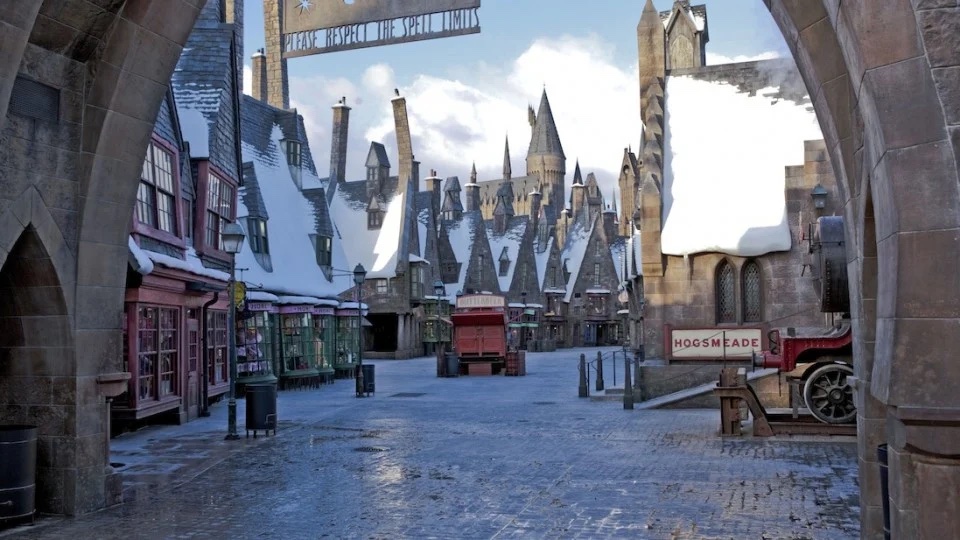
Obviously, the 2010 opening of the Wizarding World of Harry Potter changed Universal Orlando (and the entire themed entertainment industry) forever. That year saw Harry Potter and the Forbidden Journey – a uniquely high-tech dark ride – set down on a formerly-vacant and luckily-placed expansion pad. In 2014, the Hogwarts Express – Hogsmeade Station opened in conjunction with the debut of Diagon Alley. All the while, the Dragons raced on, grandfathered into the land despite the loud, colorful, bare steel coasters being contrary to the land’s otherwise immersive nature.
Finally in 2017, the Dragons were felled in favor of 2019’s Hagrid’s Magical Creatures Motorbike Adventure – still a bare steel coaster, but a much less intrusive and more Wizarding World-appropriate ride, creating the current Hogsmeade diagrammed below. Given how much pomp and circumstances surrounds Hogsmeade – and what a monumental shift it represents for the entire industry – it’s pretty wild to consider just how compact the land is…
THEN & NOW: The surprising truth is that nearly all of Merlinwood still exists – largely unchanged! – beneath the grafted-on Hogsmeade Village. Aside from new trains, the addition of Hagrid’s hut, a new name, and a bowing Hippogriff animatronic, the land’s family coaster hasn’t moved an inch. Likewise, though the route through it and the decorations within it are heavily modified, Hagrid’s Motorbike Adventure reuses the same queue building as Dueling Dragons… and even includes an Easter egg to its predecessor.
Meanwhile, the kitchen, patio, and bar of the Enchanted Oak Tavern remain, just serving the Three Broomsticks and Hog’s Head Pub instead… and without a doubt, doing a lot more business as part of the Wizarding World than they ever did as part of an Arthurian legend. To that end, nearly any other available space from Merlinwood was ceded to Hogsmeade as added retail needed to bring the land to life…
… Which meant that when it was time to expand the Wizarding World, a major closure was needed across the resort at Universal Studios Florida… Read on…


